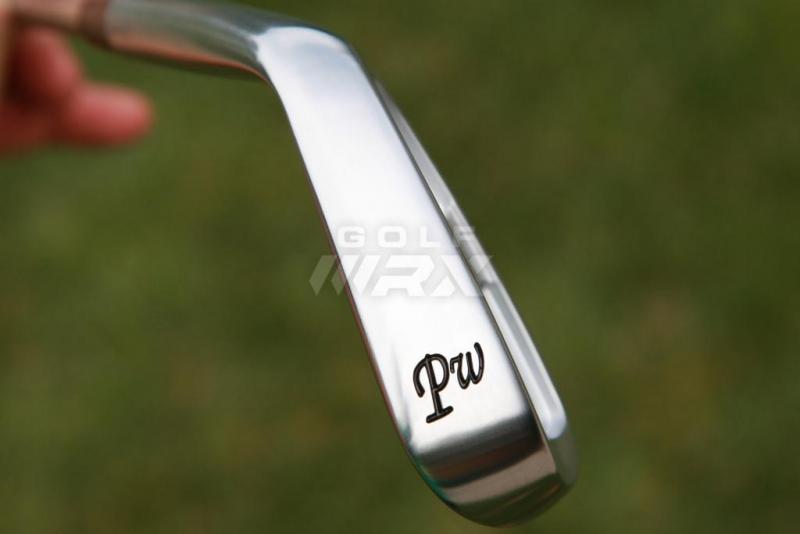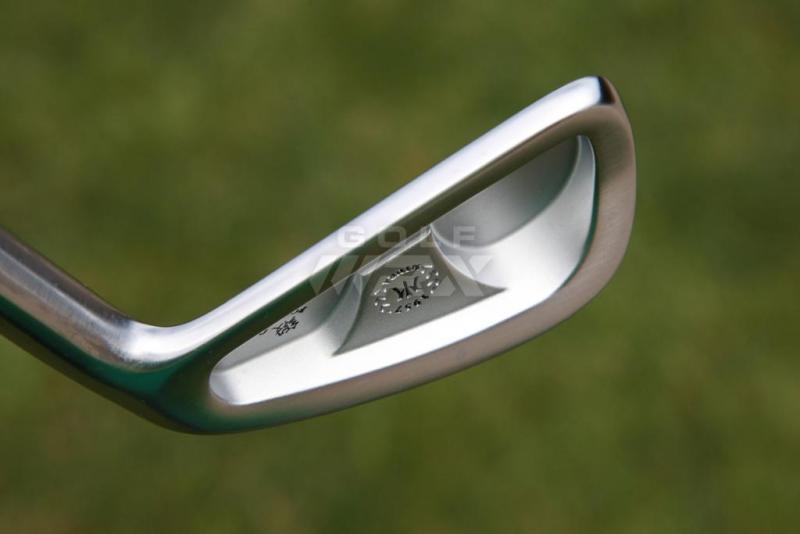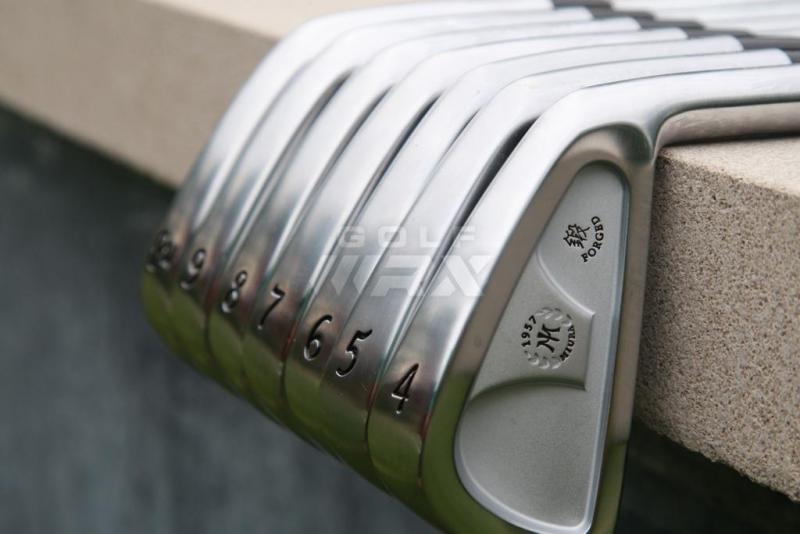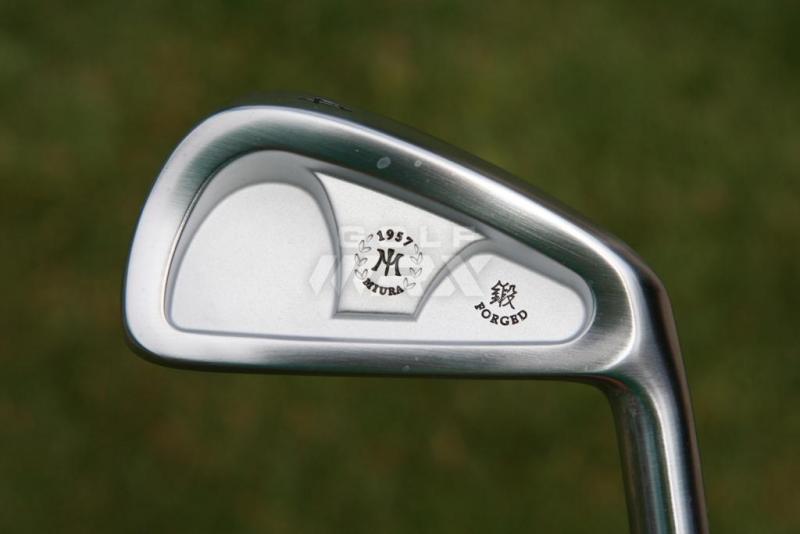Pros: The CB57’s have an incredibly soft feel. They’re made to some of the tightest tolerances in the industry, and have a beautiful nickel satin chrome finish.
Cons: Price. They’re roughly $275 per iron.
Who they’re for: Golfers who aren’t scared to pay a premium for a set of top-notch forged irons. These are slightly bigger than blades, and will work best for better players looking for irons with great feedback, workability and impressive consistency in their class.
The Review
I’ve spent my golfing life trying every club made from pretty much every brand. Although I have never designed a club myself, I often sit back staring at my clubs wishing that there was a different grind, toe shape or hosel shape. Getting those tiny details right, at least to my eye, is what I’ve found Miura does better than just about any other forged iron maker.
According to Miura, the design of the CB57’s had been percolating in the minds of the Miura family for quite a long time. They have a lot of technology packaged in these beautiful forged clubs, and the Miuras wanted to make sure it was absolutely right before they released it.
Before we go any further, let’s discuss the price. When you come across these at a Miura authorized fitting center, they will run approximately $275 per club, depending on the shaft. That’s about $2200 for an eight-piece set. Still with me? OK, read on.
The Series 1957 class has been reserved for the benchmarks of the Miura line. From the small blades, the K-Grind wedge and the KM-350 putter, these clubs are in a special class of distinction that is reserved for the most favored designs of the Miura company.
I’ve been playing the CB57’s for more than a few months now, and have spent some time examining the heads during range sessions and rounds of golf. I try to picture myself as Katsuhiro or Yoshitaka Miura and wonder what they saw when they designed clubs. What made them feel a change or development was necessary?
When I look at these irons, I’m amazed at how so much of the little features I liked in past Miura irons are how they are incorporated into the CB57 design.
Performance
For this review, I tested the CB57’s (3-PW) with Nippon N.S. Pro Modus 3 Tour 130 shafts. I’ve been playing the clubs for a few months now and have been working on this review throughout. Each time I’d have something down in print, I would have to keep updating this review, as the CB57’s continued to amazed me.
Having played several sets of Miura irons this past year including the Passing Point 9003, CB-501 and MB-001 blades, the CB57 was a set I was especially looking forward to testing.
There were many features I liked in the PP-9003, CB-501 and MB-001, but like any golf club aficionado, there were qualities in performance and looks that I wished were improved in each club. When testing the CB57’s, it seemed that all my wishes were answered and amazingly completed — in one club.
After picking up my set of CB57’s from my certified Miura fitter, I stepped into the hitting bay to give the set a few test shots. The familiar Miura feel was there, along with that lovely sound that premium forged clubs emit. The strike of the CB57 was pure and made me wish there was daylight left to get to a golf course. For that, I’d have to wait a few days.




Even after many (many) rounds with my CB57’s, they’ve continually impressed me. The forgiveness in the head, which was only slightly larger than my MB-001 set, was thrilling.
Early in the testing, I found myself wishing a shot to get legs over water. It easily hit the green, even though I struck it off the heel. I returned to my club fitter to do a few sessions on the Trackman and found that I was correct in my on-course assumptions. The CB57’s lost very little ball speed and an average, compared to similar forged cavity backs.
The irons also pleased me throughout the configuration. The 3 iron (22 degrees) was just as much of a joy to hit as the pitching wedge (47 degrees). Much of that performance, as well as the great feel of the irons, can be attributed to the weight bar in the cavity. It’s a design that not only looks great, but works tremendously as well.
In the long irons, the weight bar is smaller and positioned lower in the head. That lowers the center of gravity (CG) of the irons, which helps golfers launch the long irons higher. The fact that the weight bar is smaller in the long irons also allows more weight to be redistributed around the perimeter of the club, improving forgiveness, or moment of inertia (MOI) on mishits.
The weight bar in the short irons is positioned higher in the cavity, raising the CG, which causes shots to launch lower and with more spin. I usually hit my 8 and 9 irons much higher than I did with the CB57’s, but I didn’t mind the more piercing shots that stopped where they landed.
Another contribution of the weight bar is that solid feel you get when hitting shots with the CB57. Unlike many cavity back irons, where many golfers feel that they don’t get that solid “punch” behind the sweet spot, the weight bar of the CB57 creates a feeling of mass to the strike.
As for turf interaction, I felt that the soles of the clubs worked through the turf very well throughout the set. I tend to get steeper with my angle of attack, but I still appreciated the leading edge grind on the sole. It works great on tightly mowed grass, as well as on some of the more lush rough areas, and golfers with shallower angles of attack will likely get more benefit than I did.
I’ve heard many golfers say that they tend to “dig” too much with Miura irons, but it’s something I didn’t find in my testing. The sole allowed for a clean delivery of the club head to the ball no matter the lie at hand.
Looks and Feel



Like all Miura clubs, the first impression for me has always been wonderful. I love the rich satin finish the company puts on its irons, and the CB57 set is no different.
The Series 1957 crest is set in the middle of the weight bar on the back of each club. The kanji character for “noble” and “striving” that I first saw on the New Wedge Series is located on the heel side of the cavity.
The words “FORGED” are neatly placed in a gentle curve below the kanji, and they remind me that I am playing some of the best forgings from Himeji, Japan. I doubt if it was purposely done, but that upside down curve puts a smile on my face.
The top line has been flattened and squared off a bit more compared to other sets from Miura, which tend to be much more round. This visually gives the impression of much more forgiveness in the head, yet the top lines are still thin enough to not project any clunkiness.



Heel to toe, the CB57 is very similar in size to the MB-001’s, but they are a tad deeper in the face. A very slight offset is present in each head, again projecting a bit of forgiveness, but they’re still very pleasing to the eye of those who prefer minimal offset.
The CB57 sole is similar in width to the CB-501, yet it has the leading edge grind I first saw on the MB-001 set. I absolutely loved this leading edge grind on the MB-001’s and was extremely pleased that it was included in the CB57’s.
Compared to prior Miura sets, the number stamps on the sole have a slightly different typeface, but still project so much class on the silver nickel satin finish.
The Takeaway

There are clubs with vibration dampeners, slots, and all kinds of additions to the cavity that feel the same from heel to toe and from their bottom to the top groove. Those clubs might also allow you to hit them a mile with their boosted lofts, but that is not the golf I want to play.
The CB57’s will not allow you to do or feel any of that.
Yes, you’ll feel vibration if you mishit your shot, as I feel you should, but you’ll be left with a total unadulterated feeling of a greatly forged club.
If you’re looking for some of the most precise irons we’ve seen in the forged cavity back category, and can stomach the price tag, the CB57’s are a must-hit.
They’re not the longest irons, but they’re one of the most forgiving models in their class, offer excellent versatility, and of course, have the feel for which Miura is known. And this time around, the feel.. well, it feels just a little better.





























